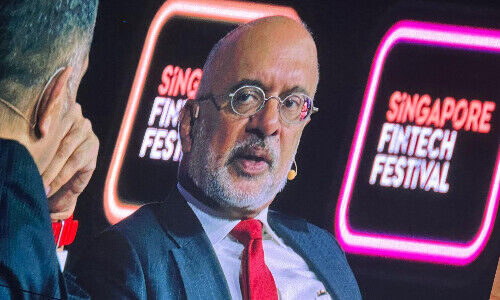Peter van der Welle: «Time Is on Xi Jinping's Side»
President Xi Jinping has likened China’s challenge of overcoming hostility abroad to a «new Long March». His analogy may also be read as a warning to Donald Trump that trade wars are not easy to win, Peter van der Welle writes in his essay on finews.first.
finews.first is a forum for renowned authors specialized in economic and financial topics. The publishers of finews.com are responsible for the selection.
President Xi Jinping has likened China’s challenge of overcoming hostility abroad to a «new Long March», a reference to the Red Army’s epic 9,000 km, year-long retreat in 1934-35 from the then ruling Nationalists. It marked the rise of Mao Zedong and the birth of the communist nation.
His comments follow President Donald Trump’s latest trade war escalation in which he raised tariffs on $200 billion of Chinese imports and threatened to slap a 25 percent tariff on another $300 billion, dashing hopes of a trade deal in May. The trade war is particularly troublesome for emerging markets equities.
«Xi's Long March analogy seems well chosen»
The International Monetary Fund (IMF) estimates that a full-blown trade war could shave 0.5 percent off U.S. economic growth and 1.5 percent off China’s. With Chinese equities selling off by 13 percent in May, investors clearly have been discounting the odds of prolonged trade tensions.
Xi's Long March analogy seems well chosen. It will still take decades for it to overtake the U.S. in terms of GDP per capita, but China’s sheer size in terms of population and the aspirational goals set by the Communist Party has already put the country in the challenger position.
The pivot may also be read as a warning to Trump that trade wars are not ‹easy to win›, especially before the November 2020 U.S. presidential elections, as China will be going for the long haul. Time may be on Xi’s side, but using this analogy also enables him to better explain an eventual near-term compromise on trade to Chinese citizens as a ‹tactical› retreat in a broader set of long-term geopolitical strife.
«China has three retaliatory weapons at its disposal»
The largest incentive for the Chinese government to seek a compromise of any sort on trade is rising unemployment and the accompanying discontent among Chinese workers. With the Chinese PMI manufacturing employment index dropping in May to the lowest reading since March 2009 (47.0), past monetary and fiscal stimulus by Chinese authorities has clearly not been enough to mitigate the hit from U.S. tariffs on an economy that was already cooling.
The first line of defense is more monetary and fiscal stimulus by Chinese policymakers, but a persistent drop in employment numbers could instill enough fear of social unrest for Chinese policymakers to eventually reach for a compromise on trade.
China has three retaliatory weapons at its disposal: restricting the rare-metal exports that the U.S. relies on upon, selling its $1.2 trillion war chest of U.S. Treasuries, and currency depreciation. The first two options are unlikely, as they would be self-defeating, but the most potent threat from the Chinese side remains a devaluation of the yuan.
«The short-term gain of a strong devaluation of the yuan would do long-term damage»
A much cheaper yuan could mitigate the impact of additional US tariffs on the remaining $325 billion of Chinese exports to the U.S. However, the lesson learned from yuan devaluation in September 2015 is that it can backfire due to spiking volatility and tightening financial conditions in Chinese markets.
Ultimately, the short-term gain of a strong devaluation of the yuan would do long-term damage, as it would undermine China’s long-term intentions to gradually further open its capital markets to foreign investors. Is it a coincidence that at a time when the risk of a managed Chinese currency depreciation as a retaliation weapon grows larger, the U.S. Treasury releases a report in which it toughens up its currency manipulation criteria? Probably not.
«Protectionism will linger for longer»
Cognizant of these self-defeating aspects of retaliation, Xi Jinping is now aiming for a «new Long March». At face value, this seems reassuring, as does his willingness to seek compromise around the upcoming G20 summit on 28 June in Osaka and his efforts to restore the recent dent in the great postwar liberalization of trade.
It is not a given though; will Chinese defense systems make use of U.S. software in the future (and vice versa)? The Chinese leader could very well be envisaging a new long march at home, not abroad. Protectionism will linger for longer.
None of this bodes well for emerging market assets. Unfortunately, the recent escalation in the China-U.S. trade tensions and the opening of new fronts by the Trump Administration create additional downside risk, especially for more export-oriented countries that benefit from global trade.
Peter van der Welle joined the financial markets research team of Robeco in October 2012 to work as a strategist. He started out as a statistical researcher with the CBS (Centraal Bureau voor de Statistiek) and continued his career as an analyst with the Dutch Bank NIBC. He earned his Master’s Degree in General Economics from the University of Tilburg, the Netherlands, in 2005.
Previous contributions: Rudi Bogni, Peter Kurer, Oliver Berger, Rolf Banz, Dieter Ruloff, Werner Vogt, Walter Wittmann, Alfred Mettler, Peter Hody, Robert Holzach, Craig Murray, David Zollinger, Arthur Bolliger, Beat Kappeler, Chris Rowe, Stefan Gerlach, Marc Lussy, Nuno Fernandes, Richard Egger, Maurice Pedergnana, Marco Bargel, Steve Hanke, Urs Schoettli, Ursula Finsterwald, Stefan Kreuzkamp, Oliver Bussmann, Michael Benz, Peter Hody, Albert Steck, Martin Dahinden, Thomas Fedier, Alfred Mettler, Brigitte Strebel, Peter Hody, Mirjam Staub-Bisang, Nicolas Roth, Thorsten Polleit, Kim Iskyan, Stephen Dover, Denise Kenyon-Rouvinez, Christian Dreyer, Kinan Khadam-Al-Jame, Robert Hemmi, Anton Affentranger, Yves Mirabaud, Katharina Bart, Frédéric Papp, Hans-Martin Kraus, Gerard Guerdat, Didier Saint-Georges, Mario Bassi, Stephen Thariyan, Dan Steinbock, Rino Borini, Bert Flossbach, Michael Hasenstab, Guido Schilling, Werner E. Rutsch, Dorte Bech Vizard, Adriano B. Lucatelli, Katharina Bart, Maya Bhandari, Jean Tirole, Hans Jakob Roth, Marco Martinelli, Beat Wittmann, Thomas Sutter, Tom King, Werner Peyer, Thomas Kupfer, Peter Kurer, Arturo Bris, Frederic Papp, James Syme, Dennis Larsen, Bernd Kramer, Ralph Ebert, Marionna Wegenstein, Armin Jans, Nicolas Roth, Hans Ulrich Jost, Patrick Hunger, Fabrizio Quirighetti, Claire Shaw, Peter Fanconi, Alex Wolf, Dan Steinbock, Patrick Scheurle, Sandro Occhilupo, Will Ballard, Michael Bornhaeusser, Nicholas Yeo, Claude-Alain Margelisch, Jean-François Hirschel, Jens Pongratz, Samuel Gerber, Philipp Weckherlin, Anne Richards, Antoni Trenchev, Benoit Barbereau, Pascal R. Bersier, Shaul Lifshitz, Klaus Breiner, Ana Botín, Martin Gilbert, Jesper Koll, Ingo Rauser, Carlo Capaul, Claude Baumann, Markus Winkler, Konrad Hummler, Thomas Steinemann, Michael Welti, Christina Boeck, Guillaume Compeyron, Miro Zivkovic, Alexander F. Wagner, Eric Heymann, Christoph Sax, Felix Brem, Jochen Moebert, Jacques-Aurélien Marcireau, Peter Hody, Ursula Finsterwald, Claudia Kraaz, Michel Longhini, Michael Welti, Stefan Blum, Zsolt Kohalmi, Karin M. Klossek, Nicolas Ramelet, Søren Bjønness, Lamara von Albertini, Andreas Britt, Gilles Prince, Fabrizio Pagani, Darren Willams, Salman Ahmed, and Stephane Monier.



























